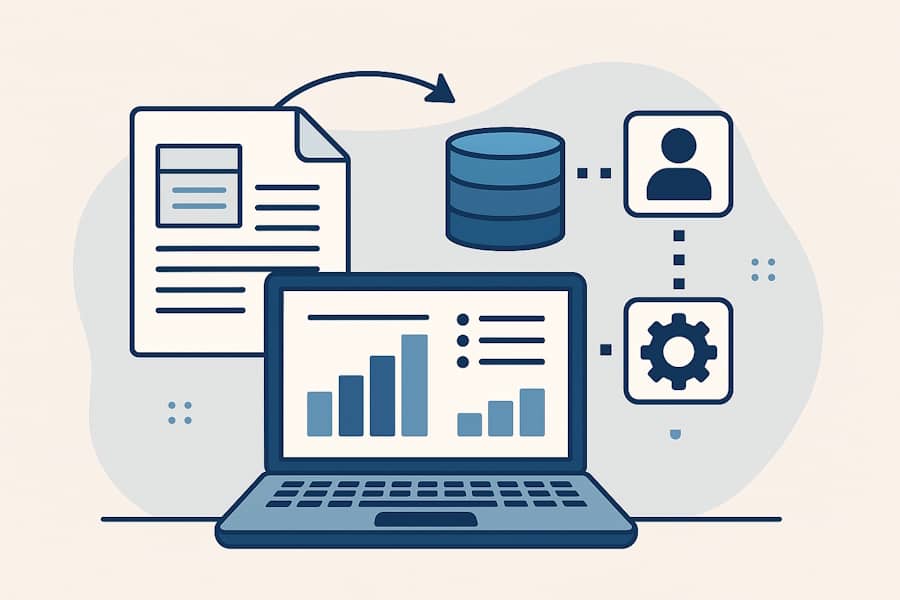In organizations that are in a highly regulated industry, compliance is no longer a legal obligation, but it is a strategic need. The amount of paperwork companies are exposed to has been increasing drastically, whether it is a contract or an invoice, an audit report, a KYC form, Human resource files, or operational records. However, the old system of compliance continues to be based on manual reviews and sluggish data input and record management.
The solution? To convert documents that stand still in the ocean of data into data that can be acted upon and the data that can be acted upon to construct automated, intelligent, and real-time compliance systems. Businesses no longer need to perceive paperwork as a load but can now consider it a potent source of organized information that propels precision, pace, and more intelligent decision-making.
Shifts in Direction to Smart Compliance.
Smart compliance is the application of automation, analytics, and AI-based solutions to ensure that regulatory accuracy is maintained without the manual load. Rather than reactive mechanisms, where compliance teams are forced to rush and correct problems as they arise, smart compliance develops proactive systems that avoid errors, identify risks early, and ensure that organizations will always be on track with the regulatory standards. This new type is fourfold in nature:
- Robotisation to end monotonous work.
- Data extraction to transform unstructured documents into searchable, user-usable data.
- Artificial intelligence to identify trends and threats.
- Continuous compliance real-time monitoring.
- These factors combined make the operation strain-free, reduce compliance costs, and increase accuracy significantly.
Why Documents Are at the Heart of Compliance?
Practically all the compliance processes are document-driven:
- Identity verification involves background checks, certificates, and ID cards.
- Basing financial compliance on statements, invoices, receipts, and audit reports.
- Medical records, treatment histories, and consent forms are all healthcare-compliant.
- Contracts, certifications, and delivery logs are the key to supplier compliance.
But the majority of such documents are not organized in the same way- PDFs, scanned pictures, or paper-written forms. Human beings have to read, verify, classify, and input the data manually, which incurs delays and errors.
Technology that Makes Compliance a Smart Possibility.
Several technologies are used in conjunction to create the current smart compliance systems:
- OCR (Optical Character Recognition): OCR turns documents into data and images into machine-readable documents, allowing automation of processes that utilized manual reading previously.
- NLP (NaturalLanguageProcessing): NLP assists systems in contextualizing information, document classification, finding important fields in documents, and interpreting unstructured text.
- RPA (Robotic Process Automation): RPA robots are used to automate processes such as cross-checking, data entry, alerts, and verification.
- AI and Machine Learning: AI examines the records of compliance, detects trends that suggest potential breaches, forecasts, and becomes more accurate as time goes on.
When combined with other tools, it becomes possible to read, comprehend, validate, and scale information.
Where Smart Compliance has the highest contribution.
The idea of smart compliance will be beneficial to nearly every industry, although it is not distributed uniformly:
- Financial Services and Banking: KYC, fraud detection, and transaction monitoring are automated and minimize risks and accelerate onboarding.
- Healthcare: Going paperless enhances information security and regulation.
- Manufacturing and Supply Chain: It is possible to monitor the certifications, safety records, and vendor compliance in real time with smart auditing systems.
- Insurance: The processing of claims is expedited, made more transparent, and becomes less susceptible to human error.
- Law and Corporate Governance: The process of contract analysis, due diligence, as well as audit trails can also be simpler, more uniform, and correct.
Such enhancements not only increase compliance but also boost customer trust and efficacy in the organization.
Fundamental Change between Paper and Intelligence
The actual change comes when the companies start to turn documents into data. Such a change permits compliance teams to think of all documents as data assets, instead of a file. Once the organizations have structured data, they will get:
- Automatic warnings in case of missing or misplaced information.
- Manual processes cannot have this degree of intelligence.
Constructing an End-to-End Smart Compliance System.
Designing a smart system of compliance would need a clear structure:
- Document Digitization
Scan the paper files and convert all the existing paper records to digital files.
- Data Extraction and Data Validation.
Extract organized information in documents via OCR and NLP tools and make sure they are correct.
- Automated Workflows
Use RPA to automate approvals, identify mismatches, process documents, or initiate compliance checks.
- In-house Compliance Dashboard.
A single dashboard provides compliance teams with a view of all processes, such as risks, alerts, document statuses, and timelines.
- AI-Driven Risk Analytics
Extraction data can be analyzed by machine learning models, and suspicious patterns or possible regulatory violations identified.
- Continuous Monitoring
The smart systems are dynamic and updated in real time, where compliance is always up to date with the changes in regulations.
Such an end-to-end process would remove any redundancies and enable compliance teams to concentrate on the high-level decision-making instead of manual paperwork.
Conclusion
Manual processes are unable to keep up with the increasingly complicated regulations. AI-based and automation-based smart compliance systems allow compliance to be quicker and more precise. Turning documents into structured information transforms the organization to act in response to the situation instead of taking the initiative to control. It has become a basic pillar of safe and competitive operation.









